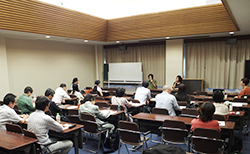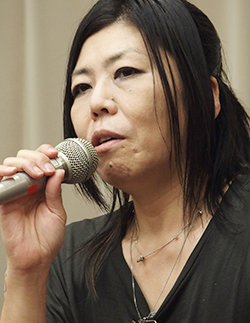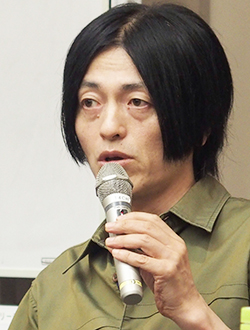IGS seminar: “Tell the Prime Minister” Screening and Talk
The film is a collection of images of memories, compiled by Oguma, from the March 11 East Japan Earthquake and Tsunami, and the demonstrations held in front of the Prime Minister’s residence soon after.
After the screening, Ms. Misao Redwolf (activist / Tokyo metropolitan area anti-nuclear alliance member), who appeared in and played a central role in the film as a demonstrator against nuclear power, spoke about her time in the film and her life after it. The protests in front of the prime minister’s residence marked the first time that individuals, rather than groups, had joined a demonstration of that scale since the end of the war. This and the use of information technology in promoting the protests were also topics of discussion.
The film’s director, Mr. Oguma, discussed how he sought to create a film that someone could watch 30, 50, and even 100 years from now without any prior knowledge of the event, and how he placed special emphasis on recording people’s expressions. The occupation of a public space in which groups of individuals using social media took decentralized leadership was also discussed—and Mr. Oguma said he felt that the convergence, for almost 3 months, of a global tide of protests occurring within Japan, needs to be analyzed further.
The facilitator Hiroaki Itai (Ochanomizu University IGS) asked each speaker one question. To Ms. Redwolf, he asked how she thought the protests in front of the prime minister’s residence affected or changed Japanese society, amidst other demonstrations against globalization, instability, and the information age. Ms. Redwolf responded by saying that an absolutely real change occurred. Prior protests were on a scale of mere hundreds to approximately 2,000 people, reaching 8,000 when organizations were mobilized, but the nuclear meltdown incident was so major that the demonstrations in front of the Prime Minister’s residence were in the millions, a massive change.
Next, Mr. Oguma was asked about the act of recording history. He pointed out that it is hard to make a record of things that do not accord with people’s preconceived notions. It is hard to make ourselves aware of things that are incongruous with the general consensus; things not recorded in history books or even recorded at all (like the rolling blackouts of 2011 for example). Perhaps the well-meaning reporters visiting the disaster area never reported on the resistance activities in Tokyo because of the stereotype that Japan is simply not a place where mass demonstrations of this scale occur. It is important to break free from such fixed notions so that the truth can be recorded. In order to do so, it is important to learn from the examples and the history of other countries.
In the question and answer session that followed, there was lively discussion about how the conversation regarding the aims of the film will continue—the people and matters discussed in the interviews, 3.11 itself, and the conceptual framework of it all.
The protests were noteworthy in Japanese society because instead of mobilized groups, the demonstrations were formed naturally and spontaneously from individuals using social media. The seminar produced meaningful discussions on the historical significance of the event.




